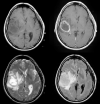Diagnostic accuracy of magnetic resonance imaging in detection of intra-axial gliomas
- PMID: 33437263
- PMCID: PMC7794124
- DOI: 10.12669/pjms.37.1.2489
Diagnostic accuracy of magnetic resonance imaging in detection of intra-axial gliomas
Abstract
Objective: To evaluate the diagnostic accuracy of magnetic resonance imaging (MRI) in detection of intra-axial gliomas in suspected cases keeping histopathology as gold standard.
Methods: This cross-sectional study was conducted at Dow Institute of Radiology, DUHS from October 2017 - April 2018. Patients of either gender aged 30-70 years presenting with headache were included. Patients already diagnosed and referred for follow up were excluded. MRI was performed on 1.5T scanner by a trained MRI technician. T1, T2, FLAIR, diffusion weighted and T1 post contrast images were acquired and reviewed by two radiologists having more than five years post fellowship experience. Sensitivity, specificity, PPV, NPV and diagnostic accuracy of MRI for intraaxial gliomas was calculated taking histopathology findings as gold standard.
Results: Mean age of the patient`s was 51.71 ±10.85 years. Positive intraaxial gliomas on MRI were observed in 123 (79.90%) patients while on histopathology, positive intraaxial gliomas were observed in 131 (85.10%) patients. Diagnostic accuracy of MRI in detection of intra-axial gliomas taking histopathology findings as gold standard showed sensitivity, specificity, positive predicted value (PPV), negative predicted value (NPV) and overall diagnostic accuracy as 89.31%, 73.91%, 95.12%, 54.84% and 87.01%.
Conclusions: MRI has high sensitivity, moderate specificity and high diagnostic accuracy in detection of intraaxial gliomas.
Keywords: Diagnostic accuracy; Glioma; Magnetic resonance imaging; Sensitivity; Specificity.
Copyright: © Pakistan Journal of Medical Sciences.
Conflict of interest statement
Conflict of interest: None.
Figures



Similar articles
-
Role of Magnetic Resonance Imaging (MRI) in grading gliomas comparable with pathology: A cross-sectional study from Syria.Ann Med Surg (Lond). 2022 Sep 17;82:104679. doi: 10.1016/j.amsu.2022.104679. eCollection 2022 Oct. Ann Med Surg (Lond). 2022. PMID: 36268388 Free PMC article.
-
Diagnostic accuracy of ultrasound in evaluation of obstructive jaundice with MRCP as gold standard.Pak J Med Sci. 2020 May-Jun;36(4):652-656. doi: 10.12669/pjms.36.4.1665. Pak J Med Sci. 2020. PMID: 32494250 Free PMC article.
-
Seminal vesicle invasion on multi-parametric magnetic resonance imaging: Correlation with histopathology.Eur J Radiol. 2018 Jan;98:107-112. doi: 10.1016/j.ejrad.2017.11.013. Epub 2017 Nov 21. Eur J Radiol. 2018. PMID: 29279147
-
The T2-FLAIR-mismatch sign as an imaging biomarker for IDH and 1p/19q status in diffuse low-grade gliomas: a systematic review with a Bayesian approach to evaluation of diagnostic test performance.Neurosurg Focus. 2019 Dec 1;47(6):E13. doi: 10.3171/2019.9.FOCUS19660. Neurosurg Focus. 2019. PMID: 31786548
-
Diagnostic accuracy of dynamic contrast-enhanced perfusion MRI in stratifying gliomas: A systematic review and meta-analysis.Cancer Med. 2019 Sep;8(12):5564-5573. doi: 10.1002/cam4.2369. Epub 2019 Aug 7. Cancer Med. 2019. PMID: 31389669 Free PMC article.
Cited by
-
Role of Magnetic Resonance Imaging (MRI) in grading gliomas comparable with pathology: A cross-sectional study from Syria.Ann Med Surg (Lond). 2022 Sep 17;82:104679. doi: 10.1016/j.amsu.2022.104679. eCollection 2022 Oct. Ann Med Surg (Lond). 2022. PMID: 36268388 Free PMC article.
-
An uncommon presentation of early brainstem high-grade glioma in a 33-year-old male: A case study and review of literature.Int J Surg Case Rep. 2024 Jan;114:109152. doi: 10.1016/j.ijscr.2023.109152. Epub 2023 Dec 13. Int J Surg Case Rep. 2024. PMID: 38141508 Free PMC article.
-
Value of Thallium-201 SPECT and SPECT/CT Brain Imaging in Differentiating Malignant From Nonmalignant Lesions: A Comparative Case-Series Study With Pathologic and/or Clinical Correlation.Brain Tumor Res Treat. 2023 Oct;11(4):239-245. doi: 10.14791/btrt.2023.0022. Brain Tumor Res Treat. 2023. PMID: 37953447 Free PMC article.
-
Diagnostic Accuracy of Magnetic Resonance Spectroscopy in Predicting the Grade of Glioma Keeping Histopathology as the Gold Standard.Cureus. 2022 Feb 9;14(2):e22056. doi: 10.7759/cureus.22056. eCollection 2022 Feb. Cureus. 2022. PMID: 35340513 Free PMC article.
-
Bridging Neuroimaging and Neuropathology: A Comprehensive Workflow for Targeted Sampling of White Matter Lesions.medRxiv [Preprint]. 2025 Jun 9:2025.06.08.25329217. doi: 10.1101/2025.06.08.25329217. medRxiv. 2025. PMID: 40585178 Free PMC article. Preprint.
References
-
- Cimino PJ, Zager M, McFerrin L, Wirsching HG, Bolouri H, Hentschel B, et al. Multidimensional scaling of diffuse gliomas:application to the 2016 World Health Organization classification system with prognostically relevant molecular subtype discovery. Acta Neuropathol Commun. 2017;5(1):39. - PMC - PubMed
-
- Latysheva A, Emblem KE, Server A, Brandal P, Meling TR, Pahnke J, et al. Survival associations using perfusion and diffusion magnetic resonance imaging in patients with histologic and genetic defined diffuse glioma world health organization grades II and III. J Comput Assist Tomogr. 2018;42(5):807–815. - PubMed
-
- Malzkorn B, Reifenberger G. Practical implications of integrated glioma classification according to the World Health Organization classification of tumors of the central nervous system 2016. Curr Opin Oncol. 2016;28(6):494–501. - PubMed
-
- Khan DA, Laghari AA, Bari ME, Shamim MS. Treatment options for paediatric brainstem gliomas. J Pak Med Assoc. 2019;69(9):1400–1402. - PubMed
LinkOut - more resources
Full Text Sources
Miscellaneous
